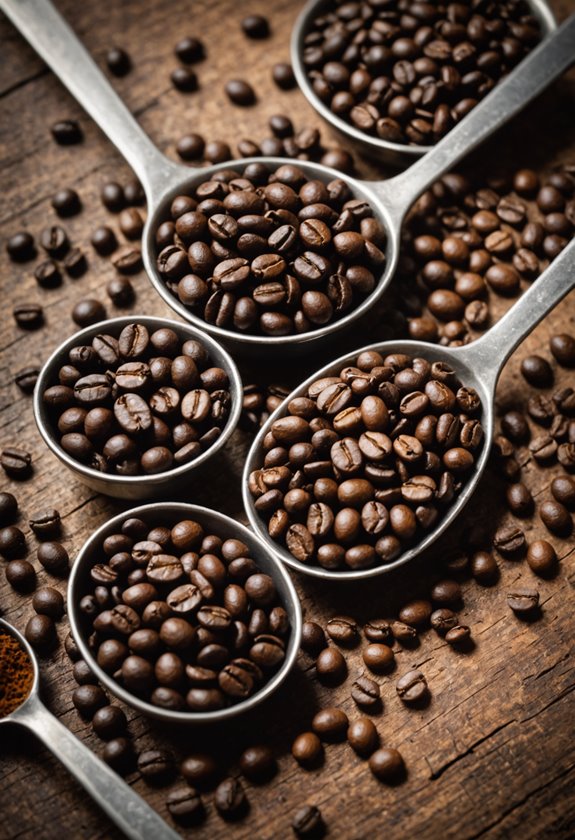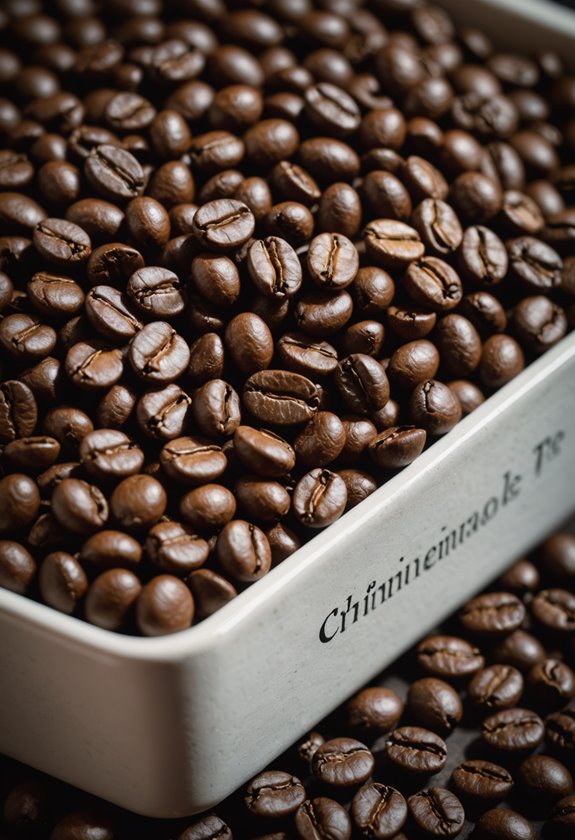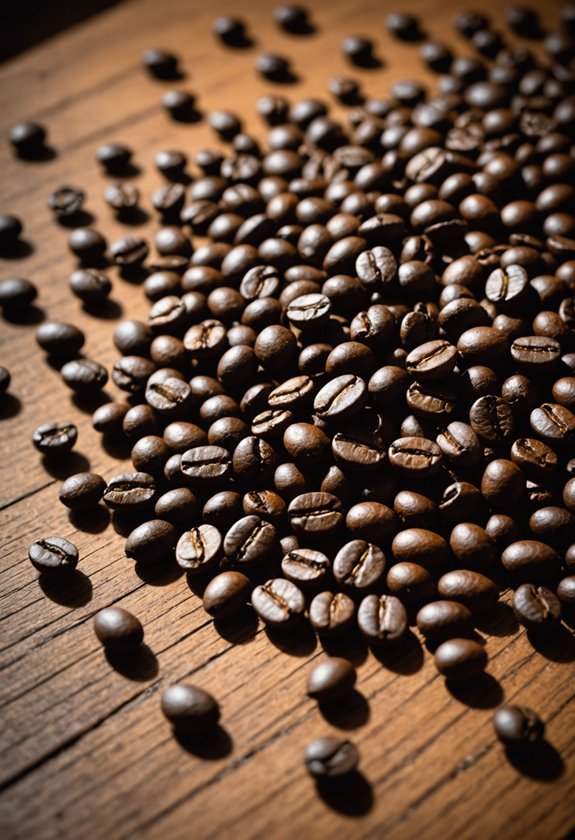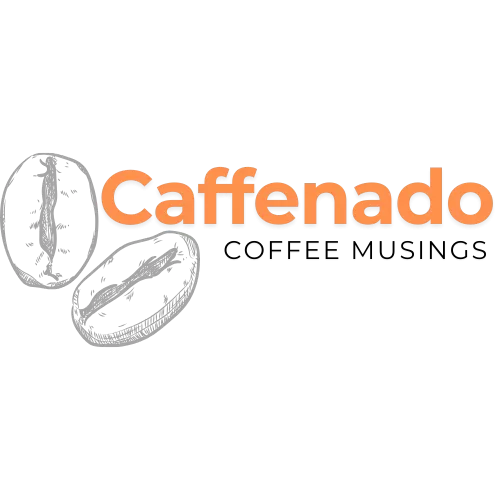How Much Caffeine Is in Coffee Beans?
When you wonder how much caffeine is in coffee beans, it's important to look at both the type of bean and other factors. Arabica beans, commonly used for their smooth, flavorful taste, contain about 6 milligrams of caffeine each. In contrast, Robusta beans, known for their stronger, more bitter flavor, have around 12 milligrams per bean. Roasting doesn't drastically change caffeine levels, though darker roasts may slightly increase concentration by weight. With brewing methods, hot techniques extract more caffeine compared to cold brews. Keep exploring to better understand how these details influence your coffee experience and preferences.
Key Takeaways
- Arabica coffee beans contain approximately 6 mg of caffeine per bean.
- Robusta coffee beans contain about 12 mg of caffeine per bean, nearly double that of Arabica.
- Arabica beans have 12 mg of caffeine per gram, while Robusta has around 22 mg per gram.
- Environmental factors and processing methods can influence the caffeine content in coffee beans.
- An 8 oz cup of coffee made from Arabica can contain between 95 to 200 mg of caffeine.
Caffeine Content in Coffee Beans

When you're investigating the caffeine content in coffee beans, it's important to know that not all beans are created equal. Arabica coffee beans, cherished for their smooth, mild flavor, contain around 1.2% caffeine. This translates to roughly 6 mg of caffeine per bean.
In contrast, Robusta beans pack a punch with a caffeine content of about 2.2%, or 12 mg per bean. This makes Robusta beans nearly twice as caffeinated as their Arabica counterparts.
Caffeine levels can be influenced by more than just the type of coffee bean. Factors such as environmental conditions, how the beans are processed, and your choice of brewing technique all play a role.
For example, darker roasted beans, often thought to have less caffeine because of their intense flavor, actually have a slightly higher caffeine concentration by weight due to the roasting process.
When you brew a typical 8 oz cup of coffee using Arabica beans, you can expect anywhere from 95 to 200 mg of caffeine, depending on how it's brewed.
Let's consider how these factors can alter your caffeine experience, ensuring you get the perfect cup every time. Understanding these variations helps in choosing the right coffee for your needs.
While both varieties have their merits, higher altitude cultivation of Arabica beans contributes to their more complex flavor profile.
Comparison of Arabica and Robusta
Now that you've got a sense of caffeine content, let's compare Arabica and Robusta beans. Arabica beans contain about 12 mg of caffeine per gram. In contrast, Robusta beans pack a punch with roughly 22 mg per gram, nearly doubling Arabica's caffeine content. This difference in caffeine levels is significant, influencing both the flavor and popularity of these coffee bean varieties.
Flavor Profile
Arabica beans are known for their smoother, more complex flavors. You'll often taste hints of fruit or sugar, making them a favorite among coffee enthusiasts.
On the other hand, Robusta beans have a stronger, more bitter taste, which some people prefer for its boldness. The high pressure brewing method of espresso can intensify these distinct flavor characteristics.
Growth and Production
Arabica plants are sensitive to environmental conditions and diseases, resulting in lower yields. Despite this, Arabica accounts for about 60% of global coffee production, highlighting its popularity. Research suggests that Arabica beans contain higher levels of chlorogenic acid, making them a healthier choice for many coffee drinkers.
Robusta, being sturdier and more pest-resistant, makes up about 40% of the market.
Varietal Factors
Both Arabica and Robusta beans vary in caffeine based on factors like growing conditions, processing methods, and specific varietals.
Understanding these differences helps you appreciate the unique qualities of each type. Let's investigate these further to deepen your coffee knowledge.
Impact of Roasting on Caffeine

While many believe that roasting burns off caffeine, in reality, the caffeine content remains relatively stable throughout the process. The roasting process primarily affects the flavor and color of the coffee beans, not the caffeine. Arabica beans, for instance, start with about 1.2% caffeine content, and this amount stays consistent even when the beans are roasted. Proper grinding consistency is crucial for extracting the optimal amount of caffeine during brewing.
Roasting Process and Bean Weight
During roasting, coffee beans lose 15-30% of their weight due to water evaporation. This weight loss doesn't decrease the caffeine percentage; instead, it can actually increase caffeine concentration by weight.
Darker roasts may seem to contain more caffeine because they become lighter and less dense, meaning there's more caffeine per gram.
Light vs. Dark Roasts
When you measure by volume, lighter roasts tend to have more caffeine than their darker counterparts. This is because darker roasted beans expand, becoming larger and less dense, which means you might use more beans for the same volume, slightly increasing the caffeine concentration in your cup.
Flavor vs. Caffeine
While longer roasting times develop a richer, bolder flavor, they don't greatly alter the caffeine in your Arabica beans.
Let's investigate how these subtle changes impact your daily brew!
Brewing Methods and Caffeine Levels
Roasting shapes the flavor of your coffee, but brewing methods truly determine the caffeine levels in your cup. Different techniques affect how much caffeine you extract, and understanding this can help you tailor your coffee experience.
Let's investigate how various brewing methods impact caffeine content.
Hot Brewing vs. Cold Brew
Hot brewing methods typically extract more caffeine due to higher temperatures. A standard drip coffee, for example, delivers about 95 mg of caffeine in an 8 oz cup.
On the other hand, cold brew takes longer to steep at lower temperatures, resulting in less caffeine extraction.
Espresso: A Concentrated Brew
Espresso stands out for its high caffeine concentration. Brewed under pressure, it packs about 63 mg of caffeine in just a 1 oz shot.
This makes espresso a potent choice, especially if you enjoy a quick caffeine enhancement.
The Role of Extraction Time
Time also plays a vital role in caffeine levels. Faster brewing methods, like espresso, may yield less caffeine than slower ones.
However, longer brewing allows more caffeine to be extracted from the grounds, potentially increasing your coffee's strength.
Choose your brewing method wisely to control the amount of caffeine in your drink.
Factors Influencing Caffeine Intake

Understanding the factors that influence your caffeine intake can help you make informed choices about your coffee consumption.
Caffeine levels in coffee beans vary greatly, starting with the type of bean. Arabica beans, common in many popular blends, contain about 6 mg of caffeine per bean. In contrast, Robusta beans pack nearly twice the punch, averaging around 12 mg of caffeine per bean. This makes your choice of beans a significant factor in determining how much caffeine you consume.
Brewing methods also impact caffeine extraction. Techniques that involve higher temperatures and longer brewing times, like the French press, typically yield more caffeine. On the other hand, cold brew methods tend to extract less caffeine due to their cooler temperatures and slower processes.
The roasting process affects caffeine levels as well. Lighter roasts usually retain more caffeine than darker ones since the roasting process causes a loss of mass. This means lighter roasts have a higher percentage of caffeine by weight.
Finally, serving size plays an essential role. An 8 oz cup of brewed coffee can contain anywhere from 95 to 200 mg of caffeine, depending on the brewing method and coffee type.
Understanding these factors allows for more control over your caffeine intake.
Low Caffeine Coffee Options
Choosing the right coffee can greatly influence your caffeine intake, especially if you're looking to cut back. Luckily, there are several low caffeine coffee options to evaluate.
Arabica Laurina, for instance, is a naturally low-caffeine variety that contains about half the caffeine of standard Arabica beans. This makes it a suitable choice if you want to enjoy coffee without the jitters.
However, naturally low-caffeine varieties like Arabica Laurina are limited, and you should be cautious, as many coffees marketed as low-caffeine may still contain considerable caffeine amounts.
Decaffeinated Coffee
Decaffeinated coffee is another popular choice for reducing caffeine intake. Typically, it contains 2 to 15 mg of caffeine per 8 oz cup, depending on the decaffeination process used.
While this is notably less than regular coffee, some decaf options may exceed this range, so it's wise to check labels if you're particularly sensitive to caffeine.
Ultra Low Caffeine Options
Some ultra low caffeine coffees use light roasts and quick extractions to minimize caffeine while maintaining flavor.
As consumer awareness of caffeine content grows, so does the demand for these options, offering you more choices customized to your health needs.
Frequently Asked Questions
How Much Caffeine Do You Get From Coffee Beans?
You can get varying amounts of caffeine from coffee beans. It depends on the bean type and roasting. Arabica and Robusta differ, and brewing methods matter too. Generally, expect around 6 mg per bean but check specifics.
How Many Coffee Beans Equal a Cup of Coffee?
You typically need about 15 to 20 coffee beans for an 8-ounce cup of coffee. The exact number depends on your grind size, brewing method, and desired strength. Adjust these factors to suit your taste preferences.
Can You Get Caffeine From Eating Coffee Beans?
Yes, you can definitely get caffeine from eating coffee beans. Each bean packs a punch, providing caffeine quickly. Just be cautious with your intake to avoid overconsumption, as the caffeine content is more concentrated than brewed coffee.
How Much Caffeine Is in Fresh Coffee Beans?
You're asking about caffeine in fresh coffee beans. Arabica beans typically have 12 mg per gram, while Robusta boasts 22 mg. Remember, factors like bean type, growing conditions, and processing methods can influence these levels considerably.
Conclusion
Let's wrap up what you've learned about caffeine in coffee beans. You now know Arabica beans generally have less caffeine than strong Robusta. Roasting doesn't change caffeine levels much, but brewing methods can vary caffeine content. Factors like bean type, roast, and brew influence your caffeine intake. If you're looking to cut down on caffeine, you have options like decaf or low-caffeine blends. So, with this knowledge, you can make informed choices about your coffee consumption.







